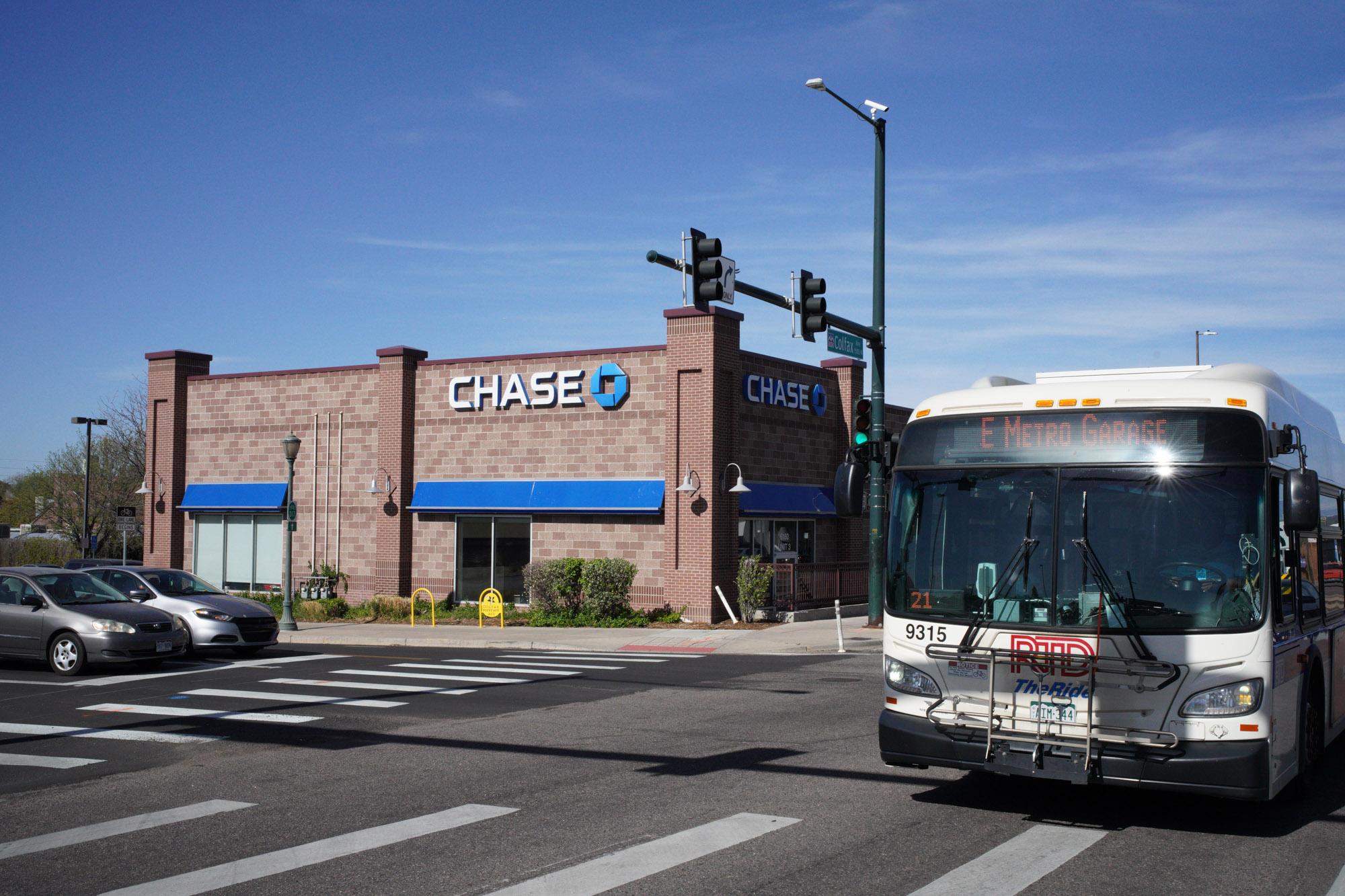
A few days before Christmas last year, a man and a woman entered a KeyBank at 2nd Avenue and Broadway in Denver donning COVID masks and caps and passed a note to a bank teller: “Hand me all your money and you will not get hurt.”
The teller, M.N., who said she was terrified, handed over a grip of bills, $1,269, along with a covert GPS tracker. The robbers fled in a dark-colored truck.
Last year in Colorado, that scene, including the threatening note and the relatively small take, happened almost 200 times.
In 2021, Colorado’s FBI field office ranked No. 1 for bank robberies in the country.
Normally, Colorado has between 110 and 120 bank robberies a year. That number dropped to 90 in 2020, during the height of the COVID-10 lockdowns. Last year, though, it spiked to 195 robberies.
“It is a lot,” said Michael Schneider, Denver FBI’s special agent in charge. “These are violent crimes. … These have a significant impact on the people who work in the banks and even the customers.”
In Denver alone, the number of bank robberies jumped from just 19 in 2020 to 65 in 2021.
One Chase branch on East Colfax Avenue was robbed four times in 2021, including twice in two days in October. Another bank, a Huntington Bank branch on South Broadway, has been hit six times since 2018, according to Denver Police.
“Typically, bank robberies are committed by individuals as an act of desperation,” Schneider said.
Law enforcement place some blame on fentanyl
Law enforcement cite something else that could be behind the despair: fentanyl.
In the last few months of 2021, investigators arrested four alleged bandits who were responsible for more than 40 robberies combined. Three out of four of those suspects told federal officials that they were supporting fentanyl addictions, Schneider said.
The alleged bandits get as little as $180 and as much as $6,143 per bank when they pass notes across counters and demand money, according to criminal complaints filed in federal court in the last two years.
In Denver, there were more robberies in November and December, including one at a credit union branch on Christmas Eve in 2021, according to data.

What the robberies look like
Many suspects demand money in increments of 100s or 50s. Some threaten tellers that they’ll get violent if they use dye packs to color the cash or GPS tracers. And they often warn bank employees, either verbally or in their hand-written notes, not to press any silent alarms.
Despite threats, many tellers hand over cash with covert electronic tracking devices attached, but experienced robbers will sometimes remove them and throw them away outside. One robber threw single dollar bills back in the face of a terrified teller. Another went to another teller in the same bank and demanded more money. They often drive their own cars to the robberies, according to criminal complaints.
About 40 percent of bank robbers get away with it.
“Out of fear, C.S. complied with the demand and gave the male $865.01 in U.S. currency from the care and control of Chase Bank. The male fled the bank in an unknown direction. No weapons were seen or threatened, but C.S. reported ‘being scared and freaking out inside,’” according to a criminal complaint filed against Owen Calvan King, who is accused of committing seven robberies across the metro area between August 2021 and December 2021.
Seldom do thieves rob a single bank. It’s typical to see one or two banks get hit in a few days by the same suspect. One man, Jordan James Nixon, faces federal charges for robbing 12 banks between November 2021 and January 2022 in Denver, Boulder, Longmont and Westminster. Another man, Joel Knerl, was indicted for robbing the same Chase branch twice in two days.
It’s also not uncommon for robbers to serve time in prison or jail for a robbery only to get out and go do it again.
Paul Hernandez, also known as the “powder puff bandit” because he used heavy makeup to cover up face tattoos, served time on federal charges related to a few 2007 bank robberies. When he got out of prison, he robbed more banks in 2020. He was arrested again and released on bond. Hernandez kept robbing banks. Authorities finally caught up to him and he accepted a plea deal in January. He is serving time in the Buena Vista Correctional Facility.
“The robber entered the bank, approached O.C. and threw an envelope at her. O.C. saw there was a note written on the envelope that O.C. read: ‘This is a robbery, give me $20,000 now.’ O.C. paused for a moment and the robber pulled a black and silver handgun from his waistband. He pointed the gun at O.C. placing her in fear for her life,” a federal criminal complaint against Hernandez said about a robbery in Westminster in August 2020. “The robber then said, “NOW!” O.C. complied with the robber’s demands and gave him the money from her teller drawer along with a covert tracking device. The robber then demanded more money, but O.C. said that was all she had. The robber took the money and left the bank. The tracking device was later found discarded in a parking lot near the bank.”
In that robbery, he left with $696.
Four most prolific robbers arrested at end of 2021
Federal officials followed Colorado’s skyrocketing bank robbery numbers warily, but note since they took four very prolific actors off the streets at the end of last year, the number has declined.
In the last quarter of 2021, there were 78 bank robberies. In the first quarter of this year, there were 44, according to FBI data.
Bank robberies are federal crimes and are usually exclusively investigated by federal authorities. State prosecutors sometimes take the cases, though, unless there are multiple robberies committed by a single person or firearms are involved.
Federal prosecutors in Colorado filed 52 counts of unarmed bank robbery charges and 10 counts of armed bank robbery charges in 2021 — more than in previous years. In 2019, for example, they filed 32 unarmed bank robbery charges.
“We view these as crimes of violence,” said Cole Finegan, Colorado’s U.S. Attorney. “If someone goes into a bank with a gun or a note, they terrify everyone in that bank. The customers and everyone working there will be traumatized by that — probably for the rest of their lives.”

Banks don’t want to talk about it
Even though bank robberies have been around since banks have been around, banking companies are notoriously tight-lipped about physical breaches in security.
They won’t talk about what they do to prevent robberies or protect their employees. They don’t talk about the support they give to employees who have gone through this — some tellers have been through it multiple times. And they forbid employees from talking about it — even anonymously.
Off the record, one executive in charge of a string of Colorado banks said private insurance companies cover the cash losses and that it was customary to provide counseling to employees who have gone through one. When asked a follow-up question, he quickly got off the phone and declined to give any more details. Later a public relations executive clarified they wouldn’t comment on any story about bank robberies.
The Colorado Bankers Association declined to help on this story or offer people to talk to — even generally — about bank security. Wells Fargo declined to comment for this story, as did U.S. Bank and KeyBank.
Worry more about liability than money losses
Don Coker, a banking security expert and consultant in Atlanta who worked in banking for almost two decades, said banks worry more about their employees and customers’ safety than they do losing money.
“The economics of it, some banks do an analysis and think, well, OK, we’re going to lose money if a robbery occurs here but if someone gets shot or injured here, we’ll be on the hook for more than what the robber will get,” said Coker, who testifies as an expert witness in bank robbery trials. “I think the bigger concern of the banks is the liability for someone being injured or an employee. That weighs on their mind more than any loss of money taken.”
FBI officials provide training for bank employees, but some banks prefer not to have armed guards out front because they believe it creates more liability — particularly if there is a confrontation between a guard and a robber.
“It’s a personal decision for each organization and some banks believe that creates additional liability,” Schneider said. “Others don’t want the confrontation to occur inside the bank. Banks are more intent on getting the robber out, keeping their customers and keeping their employees safe.”
Coker said even in the industry, leaders don’t openly discuss physical security breaches.
“I don’t see it or hear about it in industry meetings,” he said. “It’s not discussed much.”
He said cybersecurity breaches are much more top of mind.
“The robberies are bad, nobody likes it,” he said. “But they’re kind of like gnats flying around in terms of a Chase branch getting robbed compared to a cyber attack of Chase … The robbery isn’t going to hit their bottom line really. Robberies are a few thousand bucks but the cyber ones, I shudder to even think about it.”
‘Life-altering events’
The majority of the Colorado robberies in recent years are what federal law enforcement characterize as “note jobs,” which means the suspect passes a note across the desk demanding money.
Those notes, though, almost always carry a threat of violence, Schneider said, because the suspects usually note they have a weapon — even if sometimes they don’t show it or they don’t actually have one.
“In our conversations with the tellers afterwards, these are life-altering events for them,” Schneider said. “Here they are just trying to work. And as a result of these actions sometimes their lives are turned upside down.”









